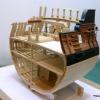-
Posts
3,084 -
Joined
-
Last visited
Reputation Activity
-
 Jaager got a reaction from pontiachedmark in HHardacre
Jaager got a reaction from pontiachedmark in HHardacre
The material that binds wood fibers - lignin - is not water soluble. It is soluble in anhydrous ammonia, an explosive and dangerous industrial agent.
It is not soluble in household (5%) or 20% ammonia. These just damage the planking. Heat will loosen lignin and allow for more bending.
Water on the surface of the wood - when contacted by a dry heat source - becomes steam and penetrates the wood with more efficiency than just dry heat alone. A microwave and wet paper towel wrapping, or direct steam will work. Soaking in hot water works - but sort of reverses the original seasoning process a bit. Ideal is to let the bent wood dry in its future conformation. If you dry in an over bent conformation, try to keep that at a slight amount.
-
 Jaager got a reaction from JeffT in HHardacre
Jaager got a reaction from JeffT in HHardacre
If the bend in the thick dimension proves difficult - wood does not readily comply to doing that - start with a wider plank and spill it to the up curve.
Spill = spoil = waste a lot of wood cutting an "S" shape. That is how it was really done - mostly. The database here has planking tutorials the explain all this.
-
 Jaager got a reaction from JeffT in HHardacre
Jaager got a reaction from JeffT in HHardacre
The material that binds wood fibers - lignin - is not water soluble. It is soluble in anhydrous ammonia, an explosive and dangerous industrial agent.
It is not soluble in household (5%) or 20% ammonia. These just damage the planking. Heat will loosen lignin and allow for more bending.
Water on the surface of the wood - when contacted by a dry heat source - becomes steam and penetrates the wood with more efficiency than just dry heat alone. A microwave and wet paper towel wrapping, or direct steam will work. Soaking in hot water works - but sort of reverses the original seasoning process a bit. Ideal is to let the bent wood dry in its future conformation. If you dry in an over bent conformation, try to keep that at a slight amount.
-
 Jaager got a reaction from mtaylor in Napolean Prisoner of War Models
Jaager got a reaction from mtaylor in Napolean Prisoner of War Models
Zero information re: the actual models,, but there are two books
Prisoner-of-war ship models, 1775-1825 Hardcover – 1973
by Ewart C Freeston
Prisoner of War: Bone Ship Models - Treasures from the Age of Napoleonic Wars Paperback – June 1, 2016
by Manfred Stein
-
 Jaager got a reaction from thibaultron in Home made thicknessing sander if
Jaager got a reaction from thibaultron in Home made thicknessing sander if
I made a machine using NRG plans - in the '70's ?
The platten was Hard Maple - The square stock was glued to a 1/2 cold rolled steel rod and the turned by a professional woodworker. I did not and do not have a full size lathe. At the time, the only media that I knew of was the 11x9 hardware store sheets, so I had the platten sized to take that = 11 inches long and 9 inches circumference. I used Weldwood contact cement. It was/ still is a bear to change. Mineral spirits and naptha denature it, but the paper backed media -- awful to remove.
I have since discovered cloth backed sanding media - it is much better.
Do over = I would keep the diameter the same - I would make the platten 12" I would allow for 2 inch thick stock.
My imagination sees a thick platten as producing a better surface.
Why 12" ?
Klingspor makes long rolls of open coat Al oxide in 3" and 4" widths.
With 12 inches, I could have 4 inches of 80 grit, 4 inches of 120 grit, and 4 inches of 220 grit.
A rubber platten is almost certain to be out of round. Commercial sleeves - vampires on your wallet.
A soft platten - Velcro = heartache.
I am pretty sure that if you use cloth backed and coat both the media and the platten with rubber cement - it should hold. It has a thinner/solvent and it is a magnitude easier than contact cement to use - easier application - a no contest for removal..
You will need to buy it in quarts.
A dust hood is vital.
I made one. It is an open box with a 2.5" shop vac connection on the top.
I made it by Titebond III gluing 3 layers of Amazon box cardboard together and using that for the 4 sides and top.
It is good quality cardboard and with two layers of PVC - it is strong and light weight.
The inside corners have 1/4" x 1/4" Pine sticks and also at the top to take the screws for the shop vac hose socket.
Covered the outside with duct tape.
Keeping it in place and having no weight/ force from the vac hose is the most difficult chore.
Jim Byrnes unit is 6" - friction clamp - easy to change -- Klingspor 3" two pieces
-
 Jaager got a reaction from pontiachedmark in Confusing Instructions - Dapper Tom
Jaager got a reaction from pontiachedmark in Confusing Instructions - Dapper Tom
They are permanent blocks fixed into the bulwarks. Old Ben just did not detail the sheave in fig. B-5. He is showing you that the top is flush with the bottom of the rail. I think at least one is for a main sail sheet. If you do not add sails, there may not be a line that uses them on your model.
With the attention this causes, I am thinking about the physics and that in this instance, the force on the sail is partially transferred to a more substantial part of the bulwark than a pin rail.
-
 Jaager got a reaction from mtaylor in Home made thicknessing sander if
Jaager got a reaction from mtaylor in Home made thicknessing sander if
I made a machine using NRG plans - in the '70's ?
The platten was Hard Maple - The square stock was glued to a 1/2 cold rolled steel rod and the turned by a professional woodworker. I did not and do not have a full size lathe. At the time, the only media that I knew of was the 11x9 hardware store sheets, so I had the platten sized to take that = 11 inches long and 9 inches circumference. I used Weldwood contact cement. It was/ still is a bear to change. Mineral spirits and naptha denature it, but the paper backed media -- awful to remove.
I have since discovered cloth backed sanding media - it is much better.
Do over = I would keep the diameter the same - I would make the platten 12" I would allow for 2 inch thick stock.
My imagination sees a thick platten as producing a better surface.
Why 12" ?
Klingspor makes long rolls of open coat Al oxide in 3" and 4" widths.
With 12 inches, I could have 4 inches of 80 grit, 4 inches of 120 grit, and 4 inches of 220 grit.
A rubber platten is almost certain to be out of round. Commercial sleeves - vampires on your wallet.
A soft platten - Velcro = heartache.
I am pretty sure that if you use cloth backed and coat both the media and the platten with rubber cement - it should hold. It has a thinner/solvent and it is a magnitude easier than contact cement to use - easier application - a no contest for removal..
You will need to buy it in quarts.
A dust hood is vital.
I made one. It is an open box with a 2.5" shop vac connection on the top.
I made it by Titebond III gluing 3 layers of Amazon box cardboard together and using that for the 4 sides and top.
It is good quality cardboard and with two layers of PVC - it is strong and light weight.
The inside corners have 1/4" x 1/4" Pine sticks and also at the top to take the screws for the shop vac hose socket.
Covered the outside with duct tape.
Keeping it in place and having no weight/ force from the vac hose is the most difficult chore.
Jim Byrnes unit is 6" - friction clamp - easy to change -- Klingspor 3" two pieces
-
 Jaager got a reaction from mtaylor in The Length of oars for a ship's boat (edited by admin)
Jaager got a reaction from mtaylor in The Length of oars for a ship's boat (edited by admin)
The Index for NRJ vol.25 1979
has a reprint of data from Secretary's Monthly Letter #6 July 1948
Specifications for oar of various boats of theUSN for the year 1900
there is a diagram and a table. There are 15 data points for each oar and 10 different oars.
I trust that it is a part of CD 1
It may produce an anacronism for an earlier time, but at least the oar would be a real oar.
-
 Jaager got a reaction from mtaylor in Confusing Instructions - Dapper Tom
Jaager got a reaction from mtaylor in Confusing Instructions - Dapper Tom
They are permanent blocks fixed into the bulwarks. Old Ben just did not detail the sheave in fig. B-5. He is showing you that the top is flush with the bottom of the rail. I think at least one is for a main sail sheet. If you do not add sails, there may not be a line that uses them on your model.
With the attention this causes, I am thinking about the physics and that in this instance, the force on the sail is partially transferred to a more substantial part of the bulwark than a pin rail.
-
 Jaager got a reaction from mtaylor in Early 18th century 50 vs 70 gun ship
Jaager got a reaction from mtaylor in Early 18th century 50 vs 70 gun ship
Scantlings of Royal Navy Ships should provide the dimensions for most everything. 50 gun 1719 is one of the entries.
Although frigates were just evolving, I am thinking that a 50 would not offer much more fire power than 44 gun frigate,
yet with the extra deck - be slower, and more cumbersome. It might be a better home for an admiral, but that is a self serving reason to build a 50 or 60.
-
 Jaager got a reaction from mtaylor in Ship building newby
Jaager got a reaction from mtaylor in Ship building newby
A common way to become overwhelmed and bail on this whole endeavor is to start with too advanced a project.
I am very old school, so grain of salt and all that:
You might take a look at MS Phantom --
Solid hull - it has beautiful lines.
A down size is that it is 1:96. That is the inflection point for entry into the miniature. That is where the physical limitations of wood enter into a simulation of components instead of replication. For a first model, that is not really a factor to worry about. You could also use a really thin veneer and try planking above the copper.
-
 Jaager got a reaction from Canute in Home made thicknessing sander if
Jaager got a reaction from Canute in Home made thicknessing sander if
I made a machine using NRG plans - in the '70's ?
The platten was Hard Maple - The square stock was glued to a 1/2 cold rolled steel rod and the turned by a professional woodworker. I did not and do not have a full size lathe. At the time, the only media that I knew of was the 11x9 hardware store sheets, so I had the platten sized to take that = 11 inches long and 9 inches circumference. I used Weldwood contact cement. It was/ still is a bear to change. Mineral spirits and naptha denature it, but the paper backed media -- awful to remove.
I have since discovered cloth backed sanding media - it is much better.
Do over = I would keep the diameter the same - I would make the platten 12" I would allow for 2 inch thick stock.
My imagination sees a thick platten as producing a better surface.
Why 12" ?
Klingspor makes long rolls of open coat Al oxide in 3" and 4" widths.
With 12 inches, I could have 4 inches of 80 grit, 4 inches of 120 grit, and 4 inches of 220 grit.
A rubber platten is almost certain to be out of round. Commercial sleeves - vampires on your wallet.
A soft platten - Velcro = heartache.
I am pretty sure that if you use cloth backed and coat both the media and the platten with rubber cement - it should hold. It has a thinner/solvent and it is a magnitude easier than contact cement to use - easier application - a no contest for removal..
You will need to buy it in quarts.
A dust hood is vital.
I made one. It is an open box with a 2.5" shop vac connection on the top.
I made it by Titebond III gluing 3 layers of Amazon box cardboard together and using that for the 4 sides and top.
It is good quality cardboard and with two layers of PVC - it is strong and light weight.
The inside corners have 1/4" x 1/4" Pine sticks and also at the top to take the screws for the shop vac hose socket.
Covered the outside with duct tape.
Keeping it in place and having no weight/ force from the vac hose is the most difficult chore.
Jim Byrnes unit is 6" - friction clamp - easy to change -- Klingspor 3" two pieces
-
 Jaager got a reaction from Canute in What type of wood is this?
Jaager got a reaction from Canute in What type of wood is this?
I know your sentiment . I am facing the same thing.
At 1:60 - a two or three decker absorbs a lot more wood than I had imagined for the framing. At larger scales the superior characteristics of true Boxwood are not really necessary. Less expensive and replaceable domestic species will suffice. At 1:96 or smaller, the Boxwood would really shine and your supply would go a long way -- ( but the amount lost to kerf and chips becomes a larger fraction ). But miniature is a whole nuther thing.
-
 Jaager got a reaction from Canute in What type of wood is this?
Jaager got a reaction from Canute in What type of wood is this?
Roger,
Are you positive your supply is Buxus simpervirens? There are other Buxus species. The stuff from Turkey and the logs from the New England supplier are a different species. Brittle is not something I would attribute to Buxus simperverins- although as far as bending, no way it comes close to Holly - a champ or Pear. With it being so scarce, I would not sacrifice it to a component that needed bending anyway.
I have a supply from a supplier on the Baltimore harbor in 1972 and a couple of small pieces from an ornamental plant. The latter has much tighter grain. Way back when, the free size was called Bermuda Box.
As I said before, someone should plant a wood lot of the tree size variety/cultivar so that their great grandchildren would have a supply.
-
 Jaager got a reaction from druxey in Early 18th century 50 vs 70 gun ship
Jaager got a reaction from druxey in Early 18th century 50 vs 70 gun ship
Scantlings of Royal Navy Ships should provide the dimensions for most everything. 50 gun 1719 is one of the entries.
Although frigates were just evolving, I am thinking that a 50 would not offer much more fire power than 44 gun frigate,
yet with the extra deck - be slower, and more cumbersome. It might be a better home for an admiral, but that is a self serving reason to build a 50 or 60.
-
 Jaager got a reaction from Cabbie in Home made thicknessing sander if
Jaager got a reaction from Cabbie in Home made thicknessing sander if
I made a machine using NRG plans - in the '70's ?
The platten was Hard Maple - The square stock was glued to a 1/2 cold rolled steel rod and the turned by a professional woodworker. I did not and do not have a full size lathe. At the time, the only media that I knew of was the 11x9 hardware store sheets, so I had the platten sized to take that = 11 inches long and 9 inches circumference. I used Weldwood contact cement. It was/ still is a bear to change. Mineral spirits and naptha denature it, but the paper backed media -- awful to remove.
I have since discovered cloth backed sanding media - it is much better.
Do over = I would keep the diameter the same - I would make the platten 12" I would allow for 2 inch thick stock.
My imagination sees a thick platten as producing a better surface.
Why 12" ?
Klingspor makes long rolls of open coat Al oxide in 3" and 4" widths.
With 12 inches, I could have 4 inches of 80 grit, 4 inches of 120 grit, and 4 inches of 220 grit.
A rubber platten is almost certain to be out of round. Commercial sleeves - vampires on your wallet.
A soft platten - Velcro = heartache.
I am pretty sure that if you use cloth backed and coat both the media and the platten with rubber cement - it should hold. It has a thinner/solvent and it is a magnitude easier than contact cement to use - easier application - a no contest for removal..
You will need to buy it in quarts.
A dust hood is vital.
I made one. It is an open box with a 2.5" shop vac connection on the top.
I made it by Titebond III gluing 3 layers of Amazon box cardboard together and using that for the 4 sides and top.
It is good quality cardboard and with two layers of PVC - it is strong and light weight.
The inside corners have 1/4" x 1/4" Pine sticks and also at the top to take the screws for the shop vac hose socket.
Covered the outside with duct tape.
Keeping it in place and having no weight/ force from the vac hose is the most difficult chore.
Jim Byrnes unit is 6" - friction clamp - easy to change -- Klingspor 3" two pieces
-
 Jaager got a reaction from JeffT in Ship building newby
Jaager got a reaction from JeffT in Ship building newby
A common way to become overwhelmed and bail on this whole endeavor is to start with too advanced a project.
I am very old school, so grain of salt and all that:
You might take a look at MS Phantom --
Solid hull - it has beautiful lines.
A down size is that it is 1:96. That is the inflection point for entry into the miniature. That is where the physical limitations of wood enter into a simulation of components instead of replication. For a first model, that is not really a factor to worry about. You could also use a really thin veneer and try planking above the copper.
-
 Jaager got a reaction from Roger Pellett in Home made thicknessing sander if
Jaager got a reaction from Roger Pellett in Home made thicknessing sander if
I made a machine using NRG plans - in the '70's ?
The platten was Hard Maple - The square stock was glued to a 1/2 cold rolled steel rod and the turned by a professional woodworker. I did not and do not have a full size lathe. At the time, the only media that I knew of was the 11x9 hardware store sheets, so I had the platten sized to take that = 11 inches long and 9 inches circumference. I used Weldwood contact cement. It was/ still is a bear to change. Mineral spirits and naptha denature it, but the paper backed media -- awful to remove.
I have since discovered cloth backed sanding media - it is much better.
Do over = I would keep the diameter the same - I would make the platten 12" I would allow for 2 inch thick stock.
My imagination sees a thick platten as producing a better surface.
Why 12" ?
Klingspor makes long rolls of open coat Al oxide in 3" and 4" widths.
With 12 inches, I could have 4 inches of 80 grit, 4 inches of 120 grit, and 4 inches of 220 grit.
A rubber platten is almost certain to be out of round. Commercial sleeves - vampires on your wallet.
A soft platten - Velcro = heartache.
I am pretty sure that if you use cloth backed and coat both the media and the platten with rubber cement - it should hold. It has a thinner/solvent and it is a magnitude easier than contact cement to use - easier application - a no contest for removal..
You will need to buy it in quarts.
A dust hood is vital.
I made one. It is an open box with a 2.5" shop vac connection on the top.
I made it by Titebond III gluing 3 layers of Amazon box cardboard together and using that for the 4 sides and top.
It is good quality cardboard and with two layers of PVC - it is strong and light weight.
The inside corners have 1/4" x 1/4" Pine sticks and also at the top to take the screws for the shop vac hose socket.
Covered the outside with duct tape.
Keeping it in place and having no weight/ force from the vac hose is the most difficult chore.
Jim Byrnes unit is 6" - friction clamp - easy to change -- Klingspor 3" two pieces
-
 Jaager got a reaction from bruce d in Home made thicknessing sander if
Jaager got a reaction from bruce d in Home made thicknessing sander if
I made a machine using NRG plans - in the '70's ?
The platten was Hard Maple - The square stock was glued to a 1/2 cold rolled steel rod and the turned by a professional woodworker. I did not and do not have a full size lathe. At the time, the only media that I knew of was the 11x9 hardware store sheets, so I had the platten sized to take that = 11 inches long and 9 inches circumference. I used Weldwood contact cement. It was/ still is a bear to change. Mineral spirits and naptha denature it, but the paper backed media -- awful to remove.
I have since discovered cloth backed sanding media - it is much better.
Do over = I would keep the diameter the same - I would make the platten 12" I would allow for 2 inch thick stock.
My imagination sees a thick platten as producing a better surface.
Why 12" ?
Klingspor makes long rolls of open coat Al oxide in 3" and 4" widths.
With 12 inches, I could have 4 inches of 80 grit, 4 inches of 120 grit, and 4 inches of 220 grit.
A rubber platten is almost certain to be out of round. Commercial sleeves - vampires on your wallet.
A soft platten - Velcro = heartache.
I am pretty sure that if you use cloth backed and coat both the media and the platten with rubber cement - it should hold. It has a thinner/solvent and it is a magnitude easier than contact cement to use - easier application - a no contest for removal..
You will need to buy it in quarts.
A dust hood is vital.
I made one. It is an open box with a 2.5" shop vac connection on the top.
I made it by Titebond III gluing 3 layers of Amazon box cardboard together and using that for the 4 sides and top.
It is good quality cardboard and with two layers of PVC - it is strong and light weight.
The inside corners have 1/4" x 1/4" Pine sticks and also at the top to take the screws for the shop vac hose socket.
Covered the outside with duct tape.
Keeping it in place and having no weight/ force from the vac hose is the most difficult chore.
Jim Byrnes unit is 6" - friction clamp - easy to change -- Klingspor 3" two pieces
-
 Jaager got a reaction from Maury S in Walnut Wood
Jaager got a reaction from Maury S in Walnut Wood
Quick and dirty: Woodcraft lists an outlet in Phoenix
They have Walnut veneer. Can be cut with steel straight edge and a sharp knife.
There are hardwood stores in Phoenix - if you have the tools to handle dimensional stock.
Walnut can be a beautiful wood for furniture or gun stocks. It is relatively hard, tight, holds an edge.
It has one bothersome characteristic - it has open pores. Not the best look when scaled down.
A tight grained closed pore species can be used and made to match Walnut by using an aqueous or alcohol aniline dye of the desired color. Not a stain - which is a surface semi transparent paint - a peritrating dye.
-
 Jaager got a reaction from mtaylor in What type of wood is this?
Jaager got a reaction from mtaylor in What type of wood is this?
I know your sentiment . I am facing the same thing.
At 1:60 - a two or three decker absorbs a lot more wood than I had imagined for the framing. At larger scales the superior characteristics of true Boxwood are not really necessary. Less expensive and replaceable domestic species will suffice. At 1:96 or smaller, the Boxwood would really shine and your supply would go a long way -- ( but the amount lost to kerf and chips becomes a larger fraction ). But miniature is a whole nuther thing.
-
 Jaager got a reaction from thibaultron in New monograph : L'Egyptienne French 24prd frigate 1799
Jaager got a reaction from thibaultron in New monograph : L'Egyptienne French 24prd frigate 1799
Thanks.
Good to know that the subject of my complaint is valid and was noticed. The bad part is that the basic hull can stand for Hebe and more than a few more French 18's and HMS Leda and a large number of RN sisters, including HMS Shannon and two that are still with us. A second supplement with the correct lines and all the variations in the derivatives may find a market. But it might give birth to kits and any scratch versions would no longer be unique.
Since L'Egyptienne looks to be correct for what I need, I look forward to exploring her.
-
 Jaager got a reaction from thibaultron in New monograph : L'Egyptienne French 24prd frigate 1799
Jaager got a reaction from thibaultron in New monograph : L'Egyptienne French 24prd frigate 1799
Gerard,
Does this include a classic Body Plan with lines inside the planking?
My complaint with the early work of your former associates regarding La Venus is that that Body Plan is outside planking.
-
 Jaager got a reaction from davyboy in What type of wood is this?
Jaager got a reaction from davyboy in What type of wood is this?
Roger,
Are you positive your supply is Buxus simpervirens? There are other Buxus species. The stuff from Turkey and the logs from the New England supplier are a different species. Brittle is not something I would attribute to Buxus simperverins- although as far as bending, no way it comes close to Holly - a champ or Pear. With it being so scarce, I would not sacrifice it to a component that needed bending anyway.
I have a supply from a supplier on the Baltimore harbor in 1972 and a couple of small pieces from an ornamental plant. The latter has much tighter grain. Way back when, the free size was called Bermuda Box.
As I said before, someone should plant a wood lot of the tree size variety/cultivar so that their great grandchildren would have a supply.
-
 Jaager got a reaction from mtaylor in What type of wood is this?
Jaager got a reaction from mtaylor in What type of wood is this?
Roger,
Are you positive your supply is Buxus simpervirens? There are other Buxus species. The stuff from Turkey and the logs from the New England supplier are a different species. Brittle is not something I would attribute to Buxus simperverins- although as far as bending, no way it comes close to Holly - a champ or Pear. With it being so scarce, I would not sacrifice it to a component that needed bending anyway.
I have a supply from a supplier on the Baltimore harbor in 1972 and a couple of small pieces from an ornamental plant. The latter has much tighter grain. Way back when, the free size was called Bermuda Box.
As I said before, someone should plant a wood lot of the tree size variety/cultivar so that their great grandchildren would have a supply.











